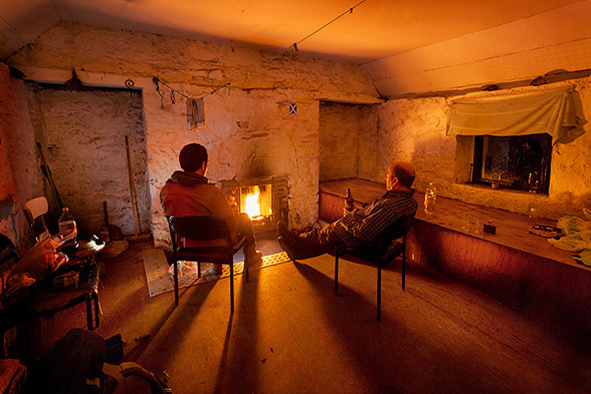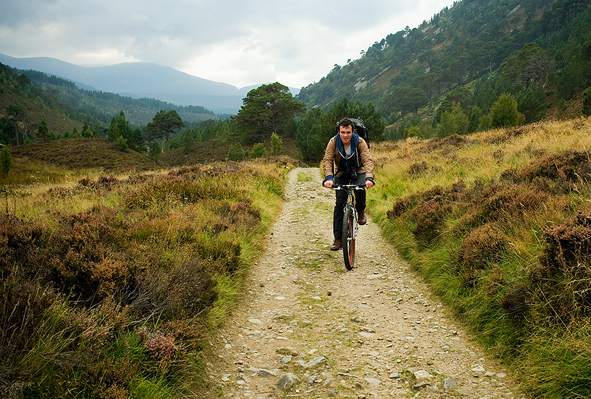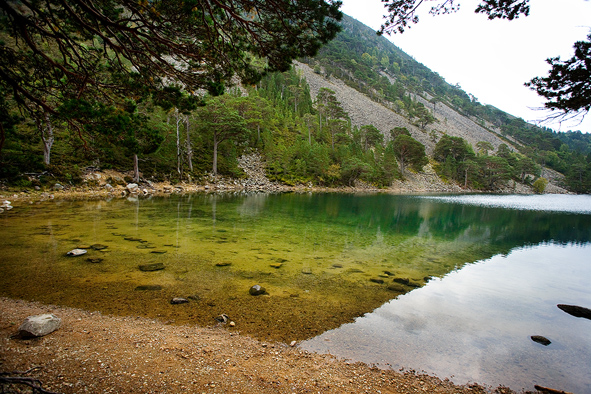Scotland is home to Britain’s wildest landscapes and remotest reaches. But out there in the wilderness, a series of rudimentary cabins, shelters and houses exist. They provide the adventurous with shelter, and if they are lucky, friendship too.

Exterior of the Ryvoan Bothy, Cairngorm National Park, Scotland. (Photo: Paul Tomkins)
Soft orange light toyed through steam rising in intricate patterns from the cooked salmon. I had just plunged my fork into the tender flaky flesh when the outer door thudded open, the wood cracking against stone. My uncle and I exchanged a wary glance.
“Hello?” I called out with some trepidation.
There was no answer, but above the wind outside, the sound of arduous movement on the other side of the inner door – a scrape and a hollow clunk – suggested we were certainly not alone.
Even the salmon seemed prone to leap off the plate in fright, but for the fact that it was still pinned beneath my fork.
Four Walls and a Roof
From outside, the squat building was only visible by the faint warm glow through the window from a modest fire. But it was the only thing visible for miles. Thick steel wool clouds had blotted out the moon and there were no settlements in the valley.
My uncle and I had cycled up through pine forest from the nearest road. The dirt track wound on, flanked by scree slopes that spilled former hill tops down towards the valley floor. We passed up onto moorland. The path flattened out becoming suffocated in places by pools of water, which glinted like sheets of stainless steel when viewed from one of the hills rising up either side of the glacial valley floor.
Sharp exertion on the pedals pushed us over the final crest before our destination. Nestled in the russet expanse of late autumn heather was Ryvoan Bothy. The ash-coloured corrugated roof was sheer to prevent a heavy build up of snow. This basic single room was now ours for the night.
Ryvoan is one of roughly a hundred bothies operated by the Mountain Bothies Association (MBA). Most of the bothies this charity maintains are in Scotland, with a smaller scattering in Wales and Northern England. All are remote, and most have only basic facilities excluding – as is the case at Ryvoan – running water or electricity. However, four sturdy walls, a roof and a fire pit can make for a surprisingly cosy environment when a little whisky and a good meal are thrown in.
Stranger in the Night
Bothies cannot be reserved. They are often far from urban areas. They are merely unmanned, unstocked caravanserais for the wanderer who is mid-peregrination and hardy enough to have no qualms about bunking down on a stone floor. Some nights a bothy may be empty, others overflowing. We were the only people who had arrived at our bothy. Darkness had now fallen and I had forgotten about our isolation. That was when the large man lumbered through our inner door.
He seemed surprised to see other people there. His eyes were bloodshot and his thick frame sagged with fatigue. At first he seemed too tired to even talk, barely grunting a ‘hello’.
We had cooked our meal of poached salmon and boiled potatoes using water from our canteens and a travel stove. We offered some to him and pulled up a chair to the small wooden table. He declined the fish but popped a new potato into his mouth, closing his eyes as he chewed. Three grown men stuffed around such a small table in the dancing light of naked flames must have made us look like ogres, picking scraps of flesh from meagre bones.
The man pulled a hunk of bread and cheese from his bag, gnawing on both like apples; he practically made a sandwich in his mouth. We shared our beer with him. Once finished he looked up from the empty bread bag at us.
“I needed that,” he said in a Black Country accent. “Long walk today. I was worried I might not make it in time.” He wiped his hand on a trouser leg and held it out to me. “I’m Bill”.
A Good Gulp of Hot Whisky at Bedtime
My uncle produced a hip flask of single malt whisky as we drew around the fire. Bill brought out a bottle of his own. The liquor’s internal-warming properties began to work at once and we settled into easy conversation.
Bill had been made redundant by both his job and wife. He had spent a number of weeks hiking in the highlands since, moving from one place to the next. Even though we have exited the recession, there are plenty of people left behind. Bill had found the hiking in solitude to be a great escape.
“You hear lots of stories of guys living in bothies in remote areas,” he said. “They’re known as feral bothyists.”
I liked this idea of living off the land; an Into the Wild that was less perilous than Alaska.
“There were a couple of instances after the recent Iraq War where somebody with post traumatic stress disorder had adopted a bothy,” Bill said. “But I have never met anyone living in one yet.”
Before setting out on this journey, I had talked to Geoff Allan, a bothy regular bothy goer who had mentioned something similar, although he had emphasised that they were only rumours.
“Out of 100 MBA bothies I’ve been to most, and there are probably another 200 functioning ones out there” Geoff told me. He documents the trips with photos on his blog. Surprisingly, this sort of publicity would have received opposition from the MBA a couple of years ago.
“The tide has turned and now they publish the grid references of each bothy on their website, but it took about six months of debate to finally do it,” he said. “There are lots of people who prefer to keep them a secret to prevent them becoming overcrowded.”
Most of the bothies are so remote that one would not expect droves of tourists flocking to them any time soon however.
Into the Wild
Back in our bothy, the fire had died down and we placed the last of our fire wood on it. The whisky meniscus had crept down the bottle and the flask was now merely an empty steel vessel, scuttled on the ground.
“What’s your favourite bothy?” my Uncle asked Bill.
“It’s a tough call,” said Bill, pursing his lips and breathing out long and slow. “Cape Wrath probably”
Uncle agreed with him. Geoff had also named that one as one of the better ones.
“But did you hear about what happened there?” asked Bill.
“What?”
“There was a girl, a few years ago. She had gone up in winter and was found dead in there,” said Bill.
Margaret Davies was an artist who had been hiking in the winter of 2002. After likely getting caught up in bad weather she found refuge in a bothy near the very remote Cape Wrath. There she starved, and was found near death by two hikers, only too late. She passed away in hospital a few hours later.
The bothy had saved her life initially, which is one reason why they exist, and most likely the sound reasoning behind the MBA publishing the grid references. However the story is a reminder that many bothies are in areas that should only be visited after meticulous preparation.
Rumours
Ryvoan was one of the less remote bothies, and certainly not difficult to find.
Bothying can become addictive. For anybody who has an affinity with the great outdoors, bothies are the ideal accompaniment to long treks. For anybody with a modicum of enthusiasm for bothies however, it is the hidden ones that are most appealing.
“I have found 15-20 places since I started that are only word of mouth. There are others that people say they would never divulge information about,” Geoff told me.
Many of the unlisted are owned by estates, or might have once been houses long since vacated. In Bill’s experience, most were in a poor state of repair. But it was another part of the allure of the Highlands; there are secrets only shared between fellow hikers; only then – if you can both sit down, share a whisky and connect – might they share the location with you.
Embers chewed away at the few remaining scraps of uncombusted wood with steady purpose. The flames were long since licked. We had fallen into silent contemplation. The wild often coaxes introspection. I always find spending time in the wild meditative.
The exertions of the day were reminding us to rest. We unrolled sleeping bags and found the flattest spot we could. Somebody upset the empty whisky bottle as they bedded down as we imparted final “sleep well’s” to our new friend. It seemed as though there would be no more unexpected visitors at such a late hour. But you never know.


